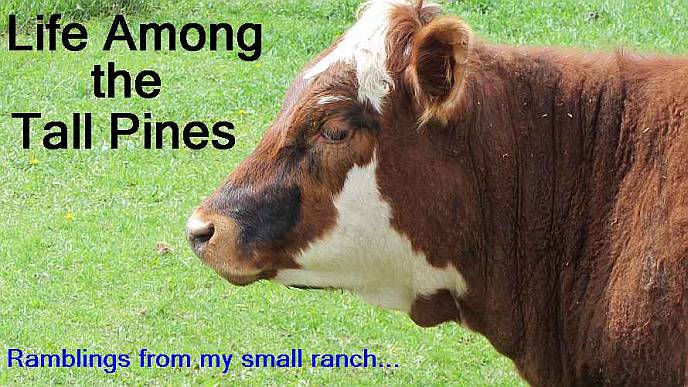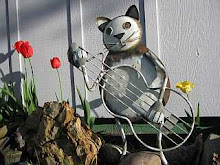Once again I was over optimistic. I thought that since the hay bales were just outside the hayshed it would take me just the afternoon to move the bales into the shed.
Wrong!
I
still don't have all the bales in the shed.
In the morning I measured and found I couldn't fit the hay rake in the shed with the bale and haybine. My estimates did have me easily fitting all the bales into the hayshed and maybe at the end I would have room for the rake.
 |
| Just fits inside the hayshed. |
I decided to set the bales on two layers of wooden pallets. I planned on having multiple levels of bales and the added weight may be too much for some pallets. Here you can see the mini-row that is between the haybine and baler hitches, and the outer pallets of the first true row.
The length of the hayshed is 64 ft. The baler and haybine took up 16 ft. The hay bales measure 5 ft long by 6 ft wide. The hayshed is 24 ft wide. I could fit four bales across on the first level; three bales on the second level, and on the third level 2 bales. And I should be able to fit 3 bales (2 plus 1) between the hitches of the baler and haybine in the mini-row.
Nine bales a row. I have around 65 bales. 9 times 7 is 63. 7 times 5 ft is 35 ft. 35 plus 16 equals 51 ft. I should have 13 ft left over for the hay rake and other stuff.
Umm... well... it didn't get off to a good start.
The first two bales seemed wide. I put one bale in place and searched for another bale that would fit. I found one.
A problem with moving bales is the bale blocks my view. I usually place the bales against one another. The challenge is the first bale in a row, especially since these bales would start at the baler and haybine and not the hayshed wall. I couldn't tell the bale was 'in place' when the pressure on the bale pushed against the tractor's bale spear. I didn't want the bale to push against the baler or haybine.
I had four bales to start as end bales. When moving the first bales I thought I saw Donna. Great. She can watch to make sure the first bales didn't push against the baler or haybine. But when I looked again she was gone. I got out of the tractor and looked all around for her in case she went over to look at the injured cow. No sign of Donna. Must have been my imagination.
So it took me a long time to set the first bales as I had to get in and out of the tractor repeatedly, especially when the tractor would move back slightly when I took it out of gear and got out of the tractor. Finally I got the first four bales set.
Then I went to place a bale on the two bales on the mini-row between the baler and haybine hitches. After I slowly pulled the bale spear out of the bale, the bale immediately slid backwards and off the bottom bales and tipped and fell onto the haybine.

Oh my god! Did I just break my haybine?
I had set the bale on top of the lower bales where it appeared from the tractor that the bales matched up. But apparently they weren't matched/set right.
I had to remove all the bales I had painstakingly just set. Then I tried to spear the bale on the haybine. But since the bale tipped on its end my spear would not penetrate the side of the bale and I started to push the bale along the haybine into the hayshed wall. So I tried to spear the bale from the bottom as part of the bottom was exposed in front of the haybine. The bale spear has one long big spear and two smaller shorter spears to prevent the bale from spinning after it is lifted. One or both of the bottom spears caught the haybine's reel so I had to try again.
On my second try I speared the bale just enough to lift it off the haybine and get the bale to the ground. I looked over the haybine and it *
appears* to be fine. I guess I'll find out next year when I cut hay.
So back to pain of setting the first four bales again. I again tried to set a bale on the bottom two mini-row bales. But I didn't feel comfortable with how the bale was sitting and gave up on setting a second level on these two bales. Even if I set the bale ok, when I set the first full row, the full row bale would press against the mini-row bale and this second level bale could get pushed just enough to be fall down onto the haybine again.
The baler and haybine were parked and I didn't want to move them. But next year I won't be parking them here and will start the rows against the hayshed wall.
On to the first full row. I took care not to push hard against the mini-row. This is where I discovered the hayshed was not exactly 24 ft wide. It is 24 ft wide on the outside. Subtract 4+ inches for the plywood and 2by6 boards for the walls. 23 ft 8 inches still should fit 4 bales. Then subtract another 10+ inches for each pole that hold the walls and roof. I am now down to a little over 22 ft. Four large bales would not fit. There goes my plan to fit all the bales in the hayshed.
I had the four slightly smaller bales I had bought from Dan. And I had two half bales from my baling. Plus a few bales that kind of - but not completely - fell apart. I used these bales to fill the first level of four bales.
The first full row still was a mess. The fourth bale was a partial/messed up bale. When it came to the second level I was unable to set three bales on the bottom four bales. When I tried to set a third bale as a kind of 2 1/2 level the bale slipped off my bale spear and fell as seen in the photo below. Part of why the bale fell was the mini-row had no second level to help support the first row's bale. At least the bale stopped at the mini-row's first level and did not go all the way back to the haybine.
I forget if it was the second or third row before the bales started stacking the way I had expected them to. Below is how the bales are supposed to stack.
It got dark before I could get all the bales inside the hayshed. I have 14 bales left to stack. Three levels is the maximum my tractor can lift. I had to be careful and slow with the third level not to touch the roof rafters when tipping and lifting the bales up.
The lower two left bales in the previous photo are grass hay. The rest are barley, oats and peas hay.
I am running out of room in the hayshed. It appears I will be able to
just fit all the bales in the hayshed - but who knows what challenges will happen tomorrow. So much for the extra 13 ft left over.
In the afternoon a breeze came up and slowly blew away some of the thick forest fire smoke. Before sunset I saw some clouds to the West. Rain clouds? Did the weather forecasters get the forecast wrong? Do I need to get the rest of the bales inside the hayshed? Nah. With all this thick smoke it has been a long time since I had seen clouds. The clouds dissipated after sunset.




















































